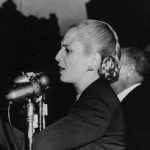 Weird Stuff
Weird Stuff  Weird Stuff
Weird Stuff  Our World
Our World 10 Ways Your Christmas Tree Is More Lit Than You Think
 Movies and TV
Movies and TV The 10 Coolest Stars to Set Sail on The Love Boat
 History
History 10 Things You Didn’t Know About the American National Anthem
 Technology
Technology Top 10 Everyday Tech Buzzwords That Hide a Darker Past
 Humans
Humans 10 Everyday Human Behaviors That Are Actually Survival Instincts
 Animals
Animals 10 Animals That Humiliated and Harmed Historical Leaders
 History
History 10 Most Influential Protests in Modern History
 Creepy
Creepy 10 More Representations of Death from Myth, Legend, and Folktale
 Technology
Technology 10 Scientific Breakthroughs of 2025 That’ll Change Everything
 Weird Stuff
Weird Stuff Ten Bizarre Facts About The Doge Meme
 Our World
Our World 10 Ways Your Christmas Tree Is More Lit Than You Think
 Movies and TV
Movies and TV The 10 Coolest Stars to Set Sail on The Love Boat
Who's Behind Listverse?

Jamie Frater
Head Editor
Jamie founded Listverse due to an insatiable desire to share fascinating, obscure, and bizarre facts. He has been a guest speaker on numerous national radio and television stations and is a five time published author.
More About Us History
History 10 Things You Didn’t Know About the American National Anthem
 Technology
Technology Top 10 Everyday Tech Buzzwords That Hide a Darker Past
 Humans
Humans 10 Everyday Human Behaviors That Are Actually Survival Instincts
 Animals
Animals 10 Animals That Humiliated and Harmed Historical Leaders
 History
History 10 Most Influential Protests in Modern History
 Creepy
Creepy 10 More Representations of Death from Myth, Legend, and Folktale
 Technology
Technology 10 Scientific Breakthroughs of 2025 That’ll Change Everything
10 Dreaded Despots Who Met Untimely Deaths
Dictators, despots, totalitarians, tyrants. Whatever you call them, brutal leaders have appeared all too often throughout history and into the present day. In fact, if you look at the broad sweep of the human story it’s easy enough to come to the conclusion that it’s democracy that’s unusual.
But dictators don’t always have things all their own way. In fact, violent death is a frequent occupational hazard, as you’ll see from this list of untimely despot deaths. Some were killed by rivals; others were swept away by an angry populace. But in general, most might say that these cruel autocrats got nothing more than their just deserts.
Related: 10 Wives of Dictators Who Met Unfortunate Ends
10 Vidkun Quisling (Norway)
Nazi-backed Norwegian dictator Vidkun Quisling has the unenviable distinction that his surname became a common alternative term for “traitor.” Born in 1887, Quisling served with the Norwegian Army and as a military attaché in Russia and Finland. After a short spell as Norway’s defense minister, he left the government to found the fascist Norwegian National Unity Party in 1933. In 1939, he met political kinsman Adolf Hitler and actually urged him to invade Norway.
The Nazis did indeed invade Norway in 1940 and appointed a German overlord—Josef Terboven—who, in turn, named Quisling “minister president” of the nation. Quisling was now effectively Norway’s dictator and, in the face of determined resistance, did his best to Nazify the nation. A stark example of this was that during his tenure, almost 1,000 Norwegian Jews were sent to their deaths in concentration camps. Norway was freed from the Nazi yoke at the end of the war in May 1945, and Quisling was arrested. Tried as a war criminal and traitor, he was executed by firing squad in October 1945.[1]
9 Nicolae Ceaușescu (Romania)
Born in 1918, Nicolae Ceaușescu had already joined the youth section of the Romanian Communist Party by the early 1930s and was imprisoned a couple of times for his political activities. It was in jail that he met his mentor, Gheorghe Gheorghiu-Dej, who went on to become Romania’s Communist dictator in 1952 with Ceaușescu as his deputy. When Gheorghiu-Dej died in 1965, Ceaușescu succeeded him as Communist leader.
Ceaușescu’s sinister secret police, the Securitate, maintained an iron grip on the people of Romania, ruthlessly crushing any dissent. They even recruited children to report on any deviance among their friends and family. Despite this seemingly immovable Communist rule of Romania, eventually, the regime fell in December 1989 as a wave of rebellions swept Eastern Europe. Ceaușescu was captured as he tried to escape along with his partner in crime, his wife Elena. The two were summarily shot by firing squad on Christmas Day 1989.[2]
8 Francisco Macías Nguema (Equatorial Guinea)
Set on the West Coast of Africa, Equatorial Guinea is sandwiched between Cameroon and Gabon. The Portuguese colonized it in the 15th century, Spain took over in 1778, and the country gained its independence in 1968. Francisco Macías Nguema was elected the new nation’s first president but soon divested himself of the inconveniences of democracy. A 1973 plebiscite on the proposition that Macías Nguema should take complete control of Equatorial Guinea returned an improbable 99.9 percent approval.
From then on, things went downhill for the benighted people of Equatorial Guinea as an increasingly eccentric Macías Nguema cruelly suppressed any opposition to his one-man rule. From a total population of at most 400,000, Nguema’s regime murdered a staggering 80,000.
Eventually, it reached a point when other members of Equatorial Guinea’s elite had taken as much as they could stomach. Macias Nguema was overthrown in a coup by his own nephew, Obiang Nguema Mbasogo, in 1979. The deposed president was tried on a range of charges, including genocide, embezzlement, and treason. The inevitable guilty verdict led to his equally inevitable execution.[3]
7 Park Chung-Hee (South Korea)
Born in 1917, Park Chung-Hee came to power in South Korea in 1961 when he led an army coup that overthrew the civilian government. Chung-Hee’s position was legitimized when he won the presidential election held two years after the coup. He now pursued a policy described as “guided democracy.” But he also set up the Korean Central Intelligence Agency (KCIA), which used the threat of communism to ruthlessly repress dissident opinion.
Then, in 1972, Chung Hee imposed martial law and a new constitution that concentrated political power in his hands. A first attempt to assassinate him in 1974 by a disgruntled North Korean supporter armed with a pistol failed, but a bullet to the head killed his wife, Yuk Young-Soo. In 1979, Chung-Hee’s close friend, erstwhile political ally and head of the KCIA, Kim Jae-Kyu, shot the president dead during a dinner party argument about how to deal with demonstrations convulsing South Korea at the time. Jae-Kyu was soon arrested and hanged as a murderer the following year.[4]
6 Laurent-Désiré Kabila (Democratic Republic of the Congo)
Laurent-Désiré Kabila seized power in the Democratic Republic of the Congo (DRC) in 1997 at the head of an armed rebellion that overthrew his predecessor, Mobutu Sese Seko. Initially, Kabila was regarded as a liberator by many Congolese who had suffered for decades under the tyrannical rule of Mobuto.
In 1998, Kabila seemed to move toward democracy with a new constitution, but the waters were muddied by the fact that opposition politicians were thrown in jail. Kabila later legislated to ban all opposition parties, making the DRC a one-party state with him firmly in command.
Much of his rule was marked by chaos, for example, when the DRC’s Banyamulenge people rose against him with the support of neighboring Rwanda and Uganda. Kabila’s reign was brought to an abrupt halt in 2001 when one of his own bodyguards shot him dead. But that wasn’t the end of the Kabila clan since Laurent’s son, Joseph Kabila, grabbed the reins of power.[5]
5 Anwar Sadat (Egypt)
Anwar Sadat, who came to power in 1970, was an elected president in what purported to be a democracy. But the truth was that opposition in Egypt under his rule was simply not tolerated. In 1978, the New York Times quoted his words, “If any person does not adhere to the values of his country, he must prepare for punishment. There will be no more compromise or tolerance.” Despite this uncompromising warning, the dictator was feted in the West.
There was one reason Western politicians were so keen on Sadat: the Camp David Accords of 1978. That was the peace treaty that Israel and Egypt signed under the auspices of President Jimmy Carter. However, diplomatic popularity did not translate into uncritical support across the Arab world or, indeed, within Egypt. In a final act of repression, 1,500 of those opposed to Sadat were jailed in 1981. That proved to be the final straw for one opposition group, Egyptian Islamic Jihad. Egyptian soldiers who were members of the faction opened fire on Sadat at a military parade, fatally wounding him.[6]
4 Benito Mussolini (Italy)
Certainly the best-known of the characters on our list, Benito Mussolini first became Italy’s prime minister in 1922, grabbing absolute power a couple of years later. Il Duce, as the Fascist styled himself, provided something of a role model for dictators in 20th-century Europe. Indeed, in the 1930s, Hitler called him “the leading statesman in the world, to whom none may even remotely compare himself.” But Mussolini dragged his nation into WWII allied to the Nazis, and that resulted in the deaths of nearly half-a-million Italians.
Mussolini was first overthrown in 1943 by his own people but dramatically rescued from his mountain-top captivity by elite Nazi troops. With German support, he then formed a Fascist administration ruling northern Italy only. But once the Allies defeated the Nazis throughout Italy in 1945, Mussolini fled north toward Germany but was captured by Italian partisans who executed him and his mistress Claretta Petacci. Their bodies were dumped in a Milan plaza where a frenzied mob beat the corpses to a pulp before suspending them upside down. As the New York Times put it, “A fitting end to a wretched life.”[7]
3 Ngo Dinh Diem (South Vietnam)
In 1955, with American backing, Ngo Dinh Diem became prime minister of the newly formed Republic of Vietnam, or South Vietnam, as it came to be known. The new nation stood in opposition to the Democratic Republic of Vietnam, commonly known as North Vietnam. Diem quickly seized absolute power as South Vietnam’s president, packing senior government positions with his own relatives. A Catholic, Diem was little loved by much of the population who were Buddhist. His unpopularity was increased by his failure to crush the North Vietnam-based Viet Cong’s guerilla raids into the South.
Diem used the fear of communism to justify his imprisonment and killing of any South Vietnamese who opposed his rule. Large, angry demonstrations erupted across South Vietnam in 1963, and the world’s attention was grabbed by the gruesome public self-immolations of three Buddhist monks and one nun. The U.S. withdrew its support from Diem, and senior army personnel staged a coup. Soldiers arrested Diem and his brother Ngo Dinh Nhu, bayoneting and shooting the two to death in the back of an army vehicle.[8]
2 Anastasio Somoza Debayle (Nicaragua)
Anastasio Somoza Debayle was actually the third member of the Somoza clan to serve as president of Nicaragua, having been preceded first by his father, Anastasio Somoza Garcia, and then his elder brother, Luis Somoza Debayle. Somoza Garcia was assassinated in 1956, a prescient portent of what was to come for his younger son. Luis stood down after a single term, actually managing to avoid assassination, and his younger brother Anastasio came to power in 1967.
Faced with the guerilla war waged by the Cuban-backed leftists, the Sandinistas, Somoza ruled Nicaragua under martial law for much of his presidency. Widespread opposition to Somoza was fired by his immense wealth, which was said to include ownership of some 50% of Nicaraguan land. Somoza’s National Guard, Britannica tells us, “was accused of wholesale torture, rape, and murder.” In 1979, President Jimmy Carter withdrew American support for Somoza, who fled into exile. It was while he was living in Paraguay in 1980 that guerilla gunmen caught up with him, shooting him to death.[9]
1 Samuel K. Doe (Liberia)
Samuel K. Doe joined the Liberian Army at the age of 18, and by 1979, he’d reached the rank of master sergeant. It was in the following year that Doe seized power in the West African nation of Liberia by leading an assault on the nation’s presidential mansion and killing President William R. Tolbert. The bloodshed didn’t end there since Doe went on to oversee the executions of 13 of Tolbert’s closest political allies.
Once he’d overthrown the Liberian government, Doe promoted himself to general and formed a military junta comprising 14 other officers from the lower ranks. In 1985, he held a presidential election amid international accusations of vote rigging. To no one’s great surprise, he was declared election winner.
Human Rights Watch declared that Doe’s 10-year reign was “characterized by its utter disregard for human rights.” In 1979, Liberia descended into a factional civil war, and the following year, Doe was captured by forces led by Prince Johnson. His subsequent brutal torture and killing were filmed, and the gruesome footage was seen around the world.[10]








